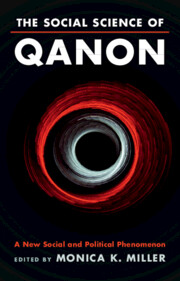Book contents
- The Social Science of QAnon
- The Social Science of QAnon
- Copyright page
- Dedication
- Contents
- Contributors
- Preface
- Part I Introduction to QAnon
- Part II Recruiting and Maintaining Followers
- Part III QAnon and Society
- Part IV The Role of Communication in Promoting and Limiting QAnon Support
- Part V The Future of QAnon
- Chapter 16 Categorizing QAnon
- Chapter 17 The Future of QAnon
- Index
- References
Chapter 16 - Categorizing QAnon
Is This a New Religious Movement?
from Part V - The Future of QAnon
Published online by Cambridge University Press: 14 September 2023
- The Social Science of QAnon
- The Social Science of QAnon
- Copyright page
- Dedication
- Contents
- Contributors
- Preface
- Part I Introduction to QAnon
- Part II Recruiting and Maintaining Followers
- Part III QAnon and Society
- Part IV The Role of Communication in Promoting and Limiting QAnon Support
- Part V The Future of QAnon
- Chapter 16 Categorizing QAnon
- Chapter 17 The Future of QAnon
- Index
- References
Summary
Over the course of 2020, QAnon repeatedly captured the news media’s attention more than ever as the group started to move its activities from online chat boards into the offline world. With increased public attention, political commentators (expert and lay) increasingly refer to QAnon as a “cult” (Blazakis, 2021; Hassan, 2021). What is missing in the growing literature on QAnon is: (1) an examination of the movement within the context of the substantial academic literature on new religious movements (NRMs); and (2) use of this research to see whether labeling QAnon a “cult” or “new religious movement” makes sense in a comparative context. In order to do this, we discuss QAnon’s fit with two widely used NRM definitions, its fit with definitions of conspiracy from religious studies literature, and its differences from and similarities to other related types of organizations, including terrorist groups, social movements, and even multilevel marketing (MLM) companies. It is this latter comparison that we spend the most time on, using the example of the company NXIVM (pronounced “NEX-ee-um”)1 to test out the NRM criteria with two loosely defined groups that have recently come to public attention and therefore do not neatly fit into the NRM discourse. This exploratory analysis is of particular importance in the case of QAnon, not only because the use of the terms “cult,” “religion,” and “conspiracy” by the public is usually divorced from academic research, but also because the terms are often used as weapons to tarnish movements that are considered to be deviant in some way.
- Type
- Chapter
- Information
- The Social Science of QAnonA New Social and Political Phenomenon, pp. 271 - 290Publisher: Cambridge University PressPrint publication year: 2023
References
- 1
- Cited by

